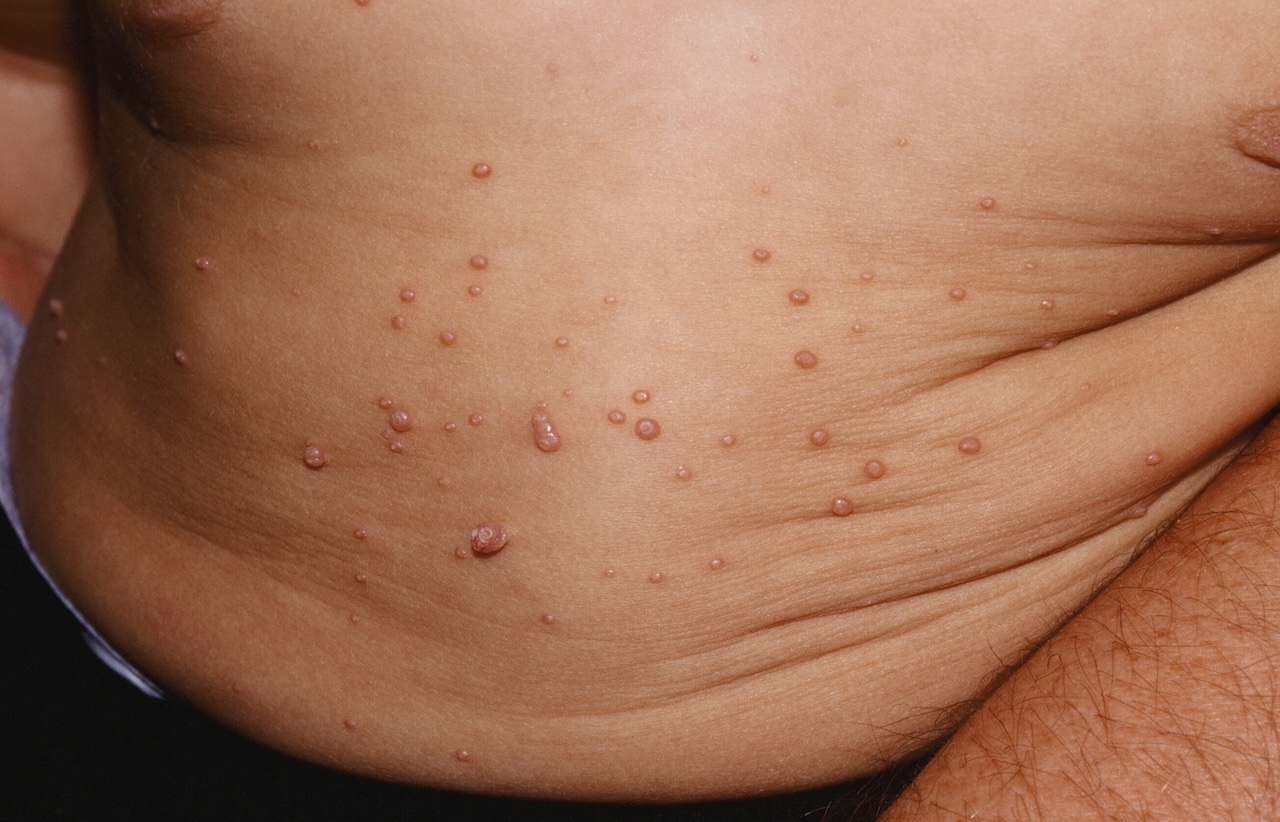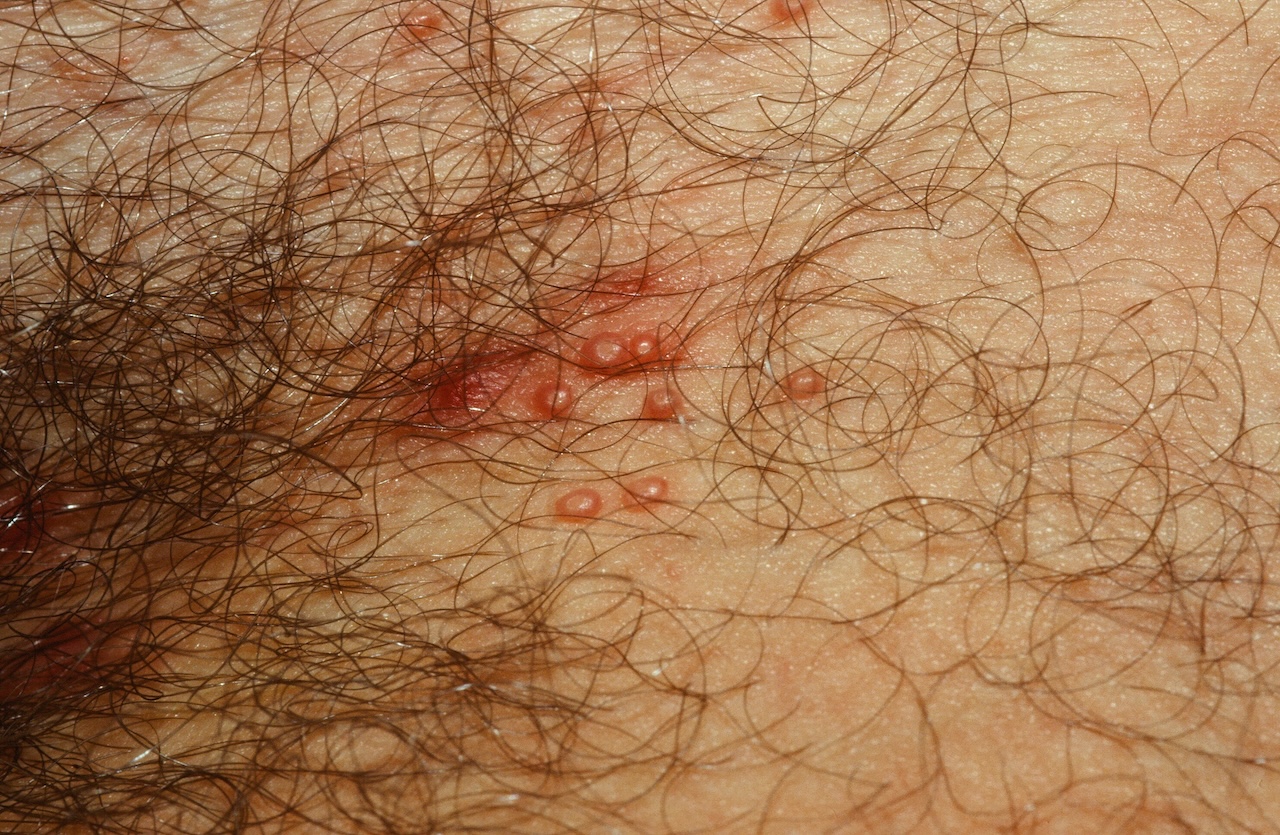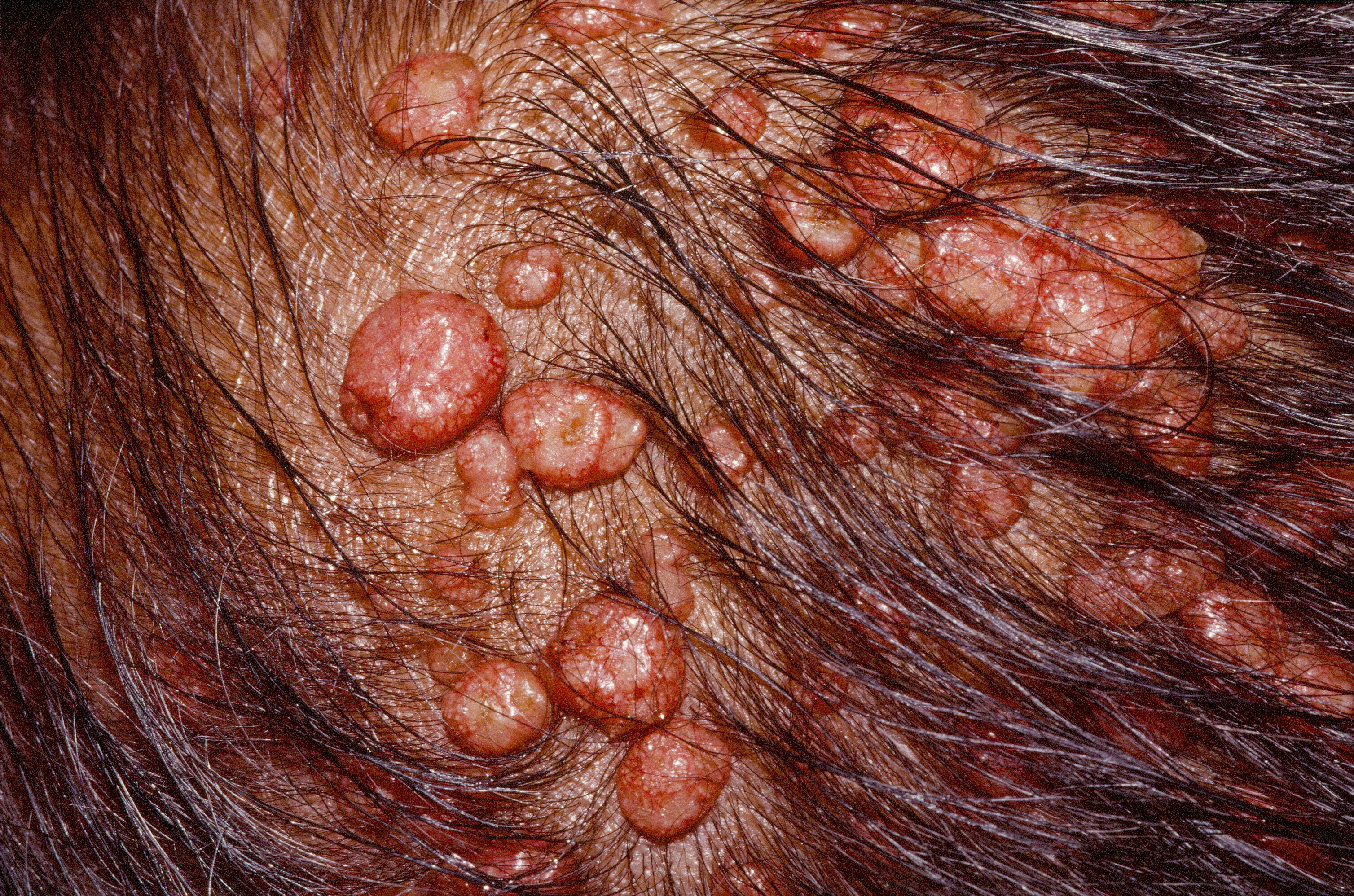
Multiple, scattered, flesh-colored papules in a child.

Multiple, scattered, flesh-colored papules in a child.
Molluscum contagiosum (MC) is a common viral infection of the skin. Small, delled, flesh-colored bumps in children and immunocompromised individuals, e.g., HIV, are characteristic. MC may be transmitted sexually in adults.
Molluscum appears as multiple flesh-colored to pink papules. A white area or dell in the center is classic. There may be only a few or over 50. They may be grouped or scattered. Often, the surrounding skin is irritated and red. Molluscum does not affect palms and soles, and involvement of oral mucosa is rare.
Molluscum in young children is often best observed as it usually remits spontaneously within months to years, with the average duration 8 months in one study and 13 months in another. Often, however, the parent does not want to wait. In another study MCV lesions completely resolved in approximately 50% of children within 12 months and in 70% within 18 months--whether they were treated or not. Treatment did not shorten the time to resolution.
Simple curretage is a very effective and commonly employed treatment. For children, one can have them come in 20 minutes early so the nurse can apply either 6% or 23% lidocaine. See patients every 3 weeks till gone. It should be emphasized that is is best to use a disposable curette (sharper) and a "quick flick" technique.
Ycanth is cantharidin applied in the office. Ycanth a bit more efficacious than Zelsuvmi.
Zelsuvmi is nitric oxide as a take home product.
Topical salicylic acid is an at-home approach that can clear molluscum. Have the parent do the following:
"Use the following for any molluscum NOT on the face or anogenitals. Apply 1-3 drops of 17% salicylic acid (e.g., DuoFilm) directly to the molluscum once a day. Each drop should be permitted to dry before the next is added. Try to keep the salicylic acid off normal skin. You can cover with a bandage. Repeat daily. If the molluscum gets significantly inflamed (e.g., red and tender), stop treatment on that lesion, wait for the irritation to go away, and see if the molluscum does as well."
Wartstick is a 40% salicylic acid paste that is cheap and can be purchased on Amazon or Walmart. It has minimal side effects and high efficacy for the treatment of molluscum which can be done at home decreasing the necessity for frequent office visits which create increased financial burden on patients and families.
The procedure is as follows: Use a toothpick for precise application of a tiny amount to each lesion. Avoid inflamed lesions. Allow to dry without touching, e.g., 3-5 minutes--or else spread and larger blister formation will occur. Cover with bandage. Have parents remove bandage and wash areas in 4-6 hours or overnight. Any blisters may be popped but don't remove the roof. Covering any open areas with a bandage may be done for comfort of the patient. Book patient back in 3 weeks. Let them know that multiple treatments are usually needed. For the first visit, consider treating only 4-5 lesions to see how patient and parents do. At follow-up visits, one can treat up to 20. It has been thought never treat the face, but one review found 94% of patients satisfied with treatment and only 20% of patients developed temporary post treat discoloration and 10% severe blistering or pain even though many were darker skinned.
Does cantharidin need to be washed off? Many pediatric dermatologists don't.
Tape stripping is a very safe at-home approach and may have benefit. Have the parent do the following:
"Roll a piece of tape around your finger sticky side out. Then tap the largest of the lesions 20 times twice a day until it becomes red and inflamed. Then stop and see if it clears. You may treat multiple lesions with this approach, but use a new piece of tape for each as it is both more effective and less likely to spread the virus. Make sure to carefully throw away the tape and keep it away from anyone's skin."
"I make a big deal about leaving the room to get a special machine and come back in with the tape dispenser. It is a great event for parent, child and siblings to all get a little piece of clear tape wound around their finger, sticky side out and to choose a test lesion to learn the method: tap each bump 20 times twice a day until they get the inflammatory response."
Tape stripping: investigational, diagnostic, and therapeutic uses in dermatology. Boiko S. Clin Dermatol 2022 Jul-Aug;40(4):355-362
Tretinoin 0.05% cream may be applied QHS by a parent with the blunt end of a cotton-tipped applicator (or Q-tip with end cut off). This often causes enough inflammation and peeling to induce resolution. The parent should stop applying the tretinoin to any lesion that has become inflamed.
Apply once in office to show parents and patient and then have them buy on Amazon.
Potassium hydroxide 10% KOH aqueous solution, applied twice daily with a cotton stick to all lesions, has been very successful in a few studies including patients as young as 1 year of age. There was complete clearance of lesions in 37 (92.5%) patients after a mean period of four weeks. Local side effects (mainly irritation, but one with hypopigmentation) were observed in 12 children (32.4%).
In a DBPCT, 10% KOH was compared to normal saline. Twenty patients, aged 2-12 years, were recruited. Parents applied a solution twice daily to lesional skin until signs of inflammation appeared. Seventy percent of children receiving topical potassium hydroxide cleared, compared with 20% in the placebo group [Pediatr Dermatol. 2006 May-Jun;23(3):279-81]. 10% KOH was compared to 15% KOH each once daily in a DB study including placebo. Both the 10% and 15% were superior to placebo and there was no benefit to going to 15% [PD 2018;35;336].
10% KOH can be purchased on Amazon.
Podofilox (Condylox) has been and seems to be a viable and effective treatment. As with warts, it is applied BID x 3 consecutive days a week.
Liquid nitrogen (cryotherapy) is quite effective for a small number of lesions in adults, as this method is reliably effective.
Unfortunately, cryotherapy is both frightening and painful to the young patient. Still, if treatment is desired, EMLA cream 5% may be applied 30-60 minutes prior to cryotherapy or curettage in order to reduce the pain. The patient should be seen Q3 weeks to treat new lesions.
IL candida can do well for molluscum. Inject 0.1 cc per lesion, 1-3 lesions. Repeat Q 2-4 weeks. Stop if no benefit after 3 treatments. In one review of 29 patients, 55% had complete resolution. In addition, 37.9% experienced partial resolution, yielding an overall response rate of 93%.
Imiquimod does NOT work for molluscum contagiosum. The original maker of imiquimod (3M) conducted two large randomized trials of imiquimod for molluscum but neither study showed any difference between imiquimod and placebo [JAMA Derm 2015;151;125]. Neither study was published.
Various studies have shown PDL to clear molluscum, even with just one treatment.
Some use cantharidin on the face [JAAD 2018;78;198], but great care must be exercised, especially around the eyes. Inflammation, blistering, dyspigmentation and rarely scarring may occur.
Tretinoin 0.1% to irritate is a good choice. Curettage can do well (see above). Can consider potassium hydroxide.
One group has used topical 20% to 35% TCA to treat hundreds of pediatric patients with facial molluscum over 13 years without resulting in any significant irritation or pigment alteration [PD 2009;26;425]. They present the following technique for proper application. "The pointed edge of broken cotton-tipped applicator is used to repeatedly apply the TCA until a white frost appears. We do not apply vaseline to the skin surrounding the lesion to be treated; however, as TCA is a caustic agent, care is taken to apply the solution only to the center of individual lesions while avoiding the surrounding healthy skin. Patients describe only a mild stinging sensation and generally tolerate application well. Given the mild discomfort associated with application, we treat as many lesions as the patient tolerates."
Refer to ophthalmology.
The prevalence of molluscum is higher in patients with atopic dermatitis. Molluscum can actually cause a dermatitis in itself. “Patients may develop eczematous plaques around one or more lesions, a phenomenon known as ‘molluscum dermatitis,’ which is more frequent in patients with atopic dermatitis.” It is estimated that 9-47% of patients with molluscum develop molluscum dermatitis.

BOTE sign. The BOTE sign (beginning of the end) refers to clinical erythema and swelling of an MC skin lesion when the regression phase begins.

Multiple delled papules in the groin of a sexually active adult is one typical presentation.

Multiple grouped papules in a young child is the other typical presentation.
 This solitary red papule in a child was thought to be a Spitz Nevus and was surgically removed. (Molluscum on histology).
This solitary red papule in a child was thought to be a Spitz Nevus and was surgically removed. (Molluscum on histology).

Giant Molluscum in HIV\
Homepage | Who is Dr. White? | Privacy Policy | FAQs | Use of Images | Contact Dr. White